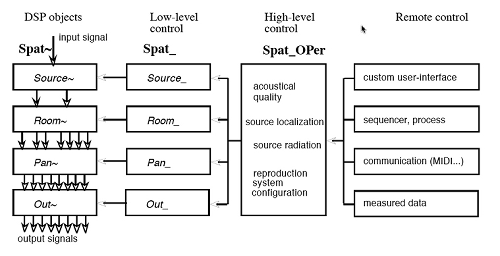Spatialisateur
Spat Introduction
|
General description of Spat~ modulesThe library of Max objects which compose Spat~ is divided in three main categories of objects: DSP objects, low-level control objects, high-level control objects (see figure below). The purpose of this organization is to allow easy configuration and construction of custom remote control pannels or mechanisms for Spat~.  General Structure of Spat~ Remote control interfaces can use both high- and low-level controls. Low-level control objects are optional: they allow one to visualize the effect of high-level controls on DSP parameters. DSP ObjectsThe signal processing in Spat~ is organized in four stages corresponding to four main DSP objects (whose names end with the `~' symbol, following the convention for signal objects in Max). Each DSP object receives and transmits one or more signals and receives control messages on its rightmost inlet. These messages are lists of symbols or numbers, according to a given syntax. Low-Level Control ObjectsTo each DSP object's control inlet a corresponding low-level control object can be connected (whose name is the same except that it ends with `_' instead of `~'). A low-level control object contains a graphical control interface made of sliders or number boxes, allowing to modify any parameter in the corresponding DSP object. The control object also has an inlet and understands the same syntax as the corresponding DSP object. Any message received on this inlet is directly transmitted to the DSP object, but can also update the sliders and number boxes in the control interface, reflecting the state of the DSP object connected on the outlet. High-Level Control ObjectsThese objects allow to define a selection of controls for modifying several DSP parameters simultaneously (possibly in different DSP objects). Each one of these high-level controls is translated into low-level control messages. As before, a high-level control can be actuated through sliders or number boxes, or updated by an incoming control message, according to a given syntax extending the low-level syntax. The Max programming environment allows the user to easily build a sequencer, automatic process or higher-level (remote) control interface which can send orders to Spat~, according to both the low-level syntax or the high-level syntax (an incoming message that does not match the high-level object's control syntax is simply transmitted through the outlet). |
© CNAC-GP/Ircam and Espaces Nouveaux |